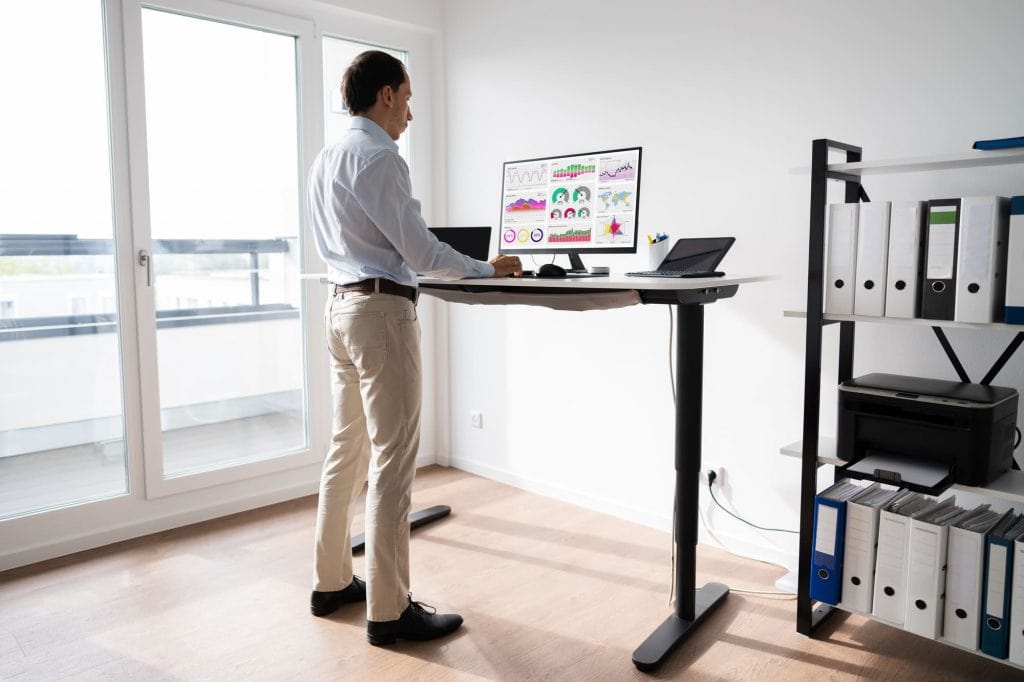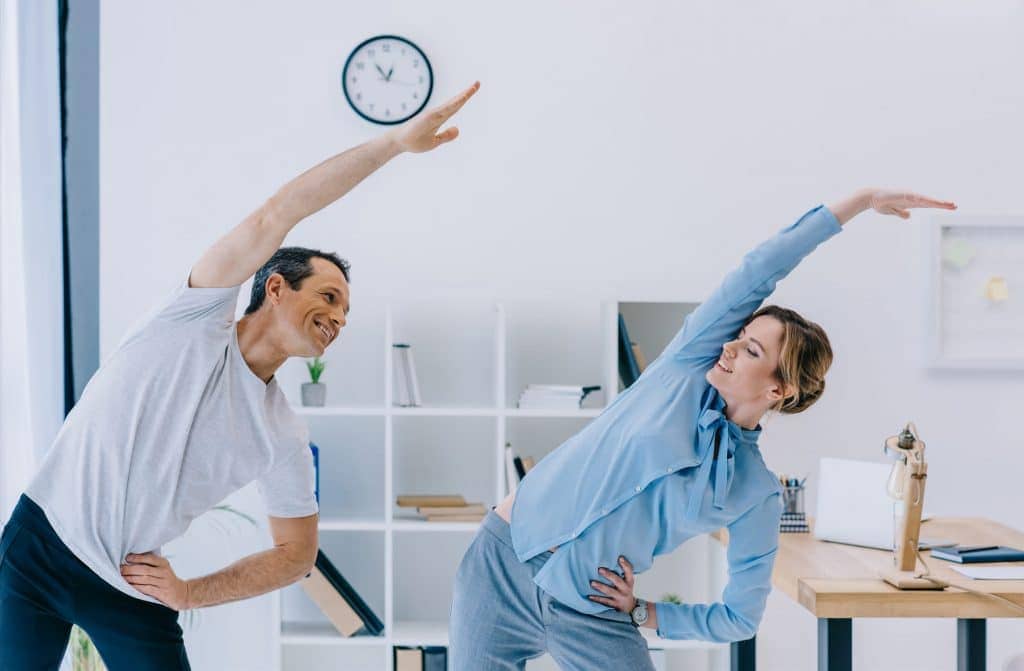*When you buy through links on our site, we may earn an affiliate commission at no additional cost to you.
There is a trending debate between experts about standing vs sitting. What Do you think? Does it have a significant influence on your health?
Let me spoiler one thing upfront. This is not going to be a laudation for standing or sit-stand desks!
Of course, there are promising results in research, but you also have to know the backgrounds, connections, and exceptions of a study.
Many people misunderstand the advice of standing while working to an extreme that takes it too far. Let’s answer this question once and for all.
Table of Contents
Sitting Side Effects
Let’s start with the side effect of sitting for prolonged periods of time. A sedentary lifestyle surely has negative side effects on your body and also the mind.
So the reason is not the standing desk, but your weak back and abdominal muscles that result in an unphysiological posture that creates pressure in your lower back, which starts hurting after a while of standing during your work.
If you’re an office worker sitting most of the time during work hours you can counterbalance the negative effects of prolonged sitting by implementing an active lifestyle and physical exercise. But more about that later.
Some of the health problems you could get from sitting:
Pretty dramatic right? But please keep in mind that those are side effects of prolonged sitting that will mostly affect couch potatoes with an inactive lifestyle.

Meaning people that prefer to watch TV, sit at the PC, or scroll their phones during their after-work hours.
Health Benefits of Standing Desks
Using a standing desk can have health benefits… when using them the right way. We’ll come to proper instruction later on in this article, but first, let’s see what studies show:
- Lowered risk of obesity, helps avoid weight gain
- Brings down your blood sugar level [5]
- Decreased risk of being diagnosed with heart disease
- Reduced upper back pain and neck pain [6]
- Improved energy level and mood
- Enhanced productivity
- Reduced caffeine dependency
- Standing adds into your healthy years
- more calories burned than sitting
As you can see standing desks seem to be the remedy for all kinds of modern society diseases. But that will only be the case if you use them the correct way.
Weight loss study
A study in the European Journal of Preventive Cardiology [7] shows the difference in energy expenditure while sitting versus standing.
A male of around 65kg could lose about 2,5kg of body fat mass within a year by substituting sitting for 6 hours per day with standing.
But the benefits of standing desks for weight loss can be neglectable.
The reason for that is, standing just burns slightly more calories than sitting and as we will learn below you shouldn’t stand for prolonged periods of time.

A study done by the Journal of Physical Activity & Health [8] shows that the amount of burnt calories by substituting sitting with standing at work is insufficient to lose a lot of weight and also you shouldn’t stand the whole day.
So if you want to avoid weight gain, simply by standing more, I have to disappoint you, that’s not the best strategy. But even moderate activity like taking a walk burns far more calories than merely standing.
Many people, who mistake the advice of standing while working, do it too excessively and start having similar or even worse health issues. Why is that?
Let’s see what standing the whole day does to your body.
Standing Side Effects
People who have to stand for multiple hours per day will know the struggle. How come, nurses, waitresses, or construction workers aren’t considered the healthiest jobs?
A study by the American Journal of Epidemiology in 2017 found out that people who are standing at work rather than sitting, have 2-fold risk of heart disease [9].
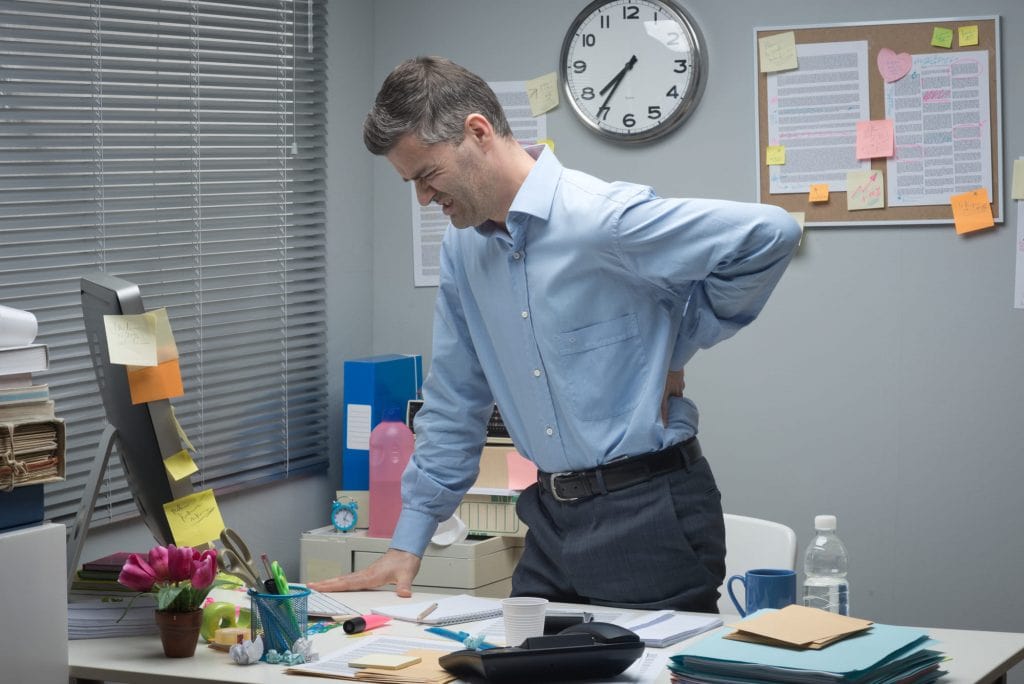
Being forced to stand 8 hours per day due to the nature of your job can have dramatic results on your health.
Others are:
- long-term chronic back-pain
- musculoskeletal disorders
- excessive lower-limb fatigue/muscle pain
- increased pressure in the veins
- increase in oxidative stress
- foot pain
Okay, so if that are the effects of standing, why do people promote standing desks that much?
Because they are not about standing all day but switching up your positions. It’s not the standing position that will gain positive effects but the plus of physical activity.
What’s Missing In Standing Desk Research
Incomplete Interpretation
The results from studies can be misleading. Only because research found that standing desks can have a lot of positive effects doesn’t mean you should use them the whole day.
There is some misinterpretation of the results, that can lead to incomplete instruction.
It’s also possible that people who participate in a trial feel better because of the positive attention or even start living healthier overall.
Not Suitable For Every Desk Job
Furthermore, you should always consider the peer group that has been tested. Not every job is necessarily suitable for standing desks.
Sometimes it’s also possible that standing can be disadvantageous for your work, especially if it requires a lot of focus or filigree work.

Other Factors
Additionally, when using a standing desk, you should also have other tools to make your sit-stand workstation healthier.
You should consider having comfortable shoes when standing, or an anti-fatigue mat. Also, complement your desk with a nice ergonomic chair and do active breaks to get the most return on the least effort.
The whole point
Studies show the negative side effects of prolonged sitting, others show similar health issues while standing.
Now that’s causing this huge debate on whether to stand or to sit. But the whole point of all the studies is the similarity of those positions: They are static.
Working environments, workstations, and the whole office working industry are slowly changing and there’s a reason why.
What Should Office Workers Do?
Neither standing or sitting for the whole day is the best option. The human body is not meant to stay in a static position for multiple hours every single day.
We’re built to be active creatures. Thus a sedentary lifestyle that forces the body to remain static is unhealthy. The same applies to standing.
How To Use A Standing Desk Properly
Here are a few tips to get the best out of your workplace. Using a staining desk the right way instead of prolonged sitting every day changes a lot.
Change Positions
The single most important takeaway from the whole standing vs sitting debate is to change your positions constantly (if you can and it suits your workflow).
All the mentioned health benefits of standing desks come from using up more calories, through the process of switching positions, more muscle activity while standing, stretching out your hip flexors, better blood circulation, and thus more oxygen, and getting that extra bit of activity.
But if you overdo it, and keep standing for the whole day the negative effects will prevail. Thus change and switch positions every now and then while you’re working.
Increase the time gradually
A lot of standing desks even have timers you can set to remind yourself to stand up.
Start with just a couple of minutes. Everybody has a different starting point because of their physical capacity.
You will notice that standing at your desk can feel quite exhaustive in the beginning, so you’ll need to get used to it.
Start with around 10 minutes and sit down for the rest of the hour. Set a timer to remind yourself to get up again when the hour is over and add one minute each day.
If you’re able to stand for half an hour you’re already doing very well. The maximum we recommend is standing for one hour and then sitting down again.
Yet it can also be disruptive and your productivity can suffer. Thus find intervals that suit your personal workday best.
For example. If you have work that requires a lot of focus, sit down. If you have a meeting or doing phone calls, stand up.
The right height
First of all, consider ergonomic guidelines to adjust your desk and chair to the optimal height.
Make sure the height of the desktop matches the height of your armrests, so your forearms can rest on the desktop in a relaxed way, while your elbow is at a 90-degree angle.
Your feet should be flat on the ground while your knees are also bent in a 90-degree position. If your seat is too high you can use a footrest, so your feet don’t dangle in the air.
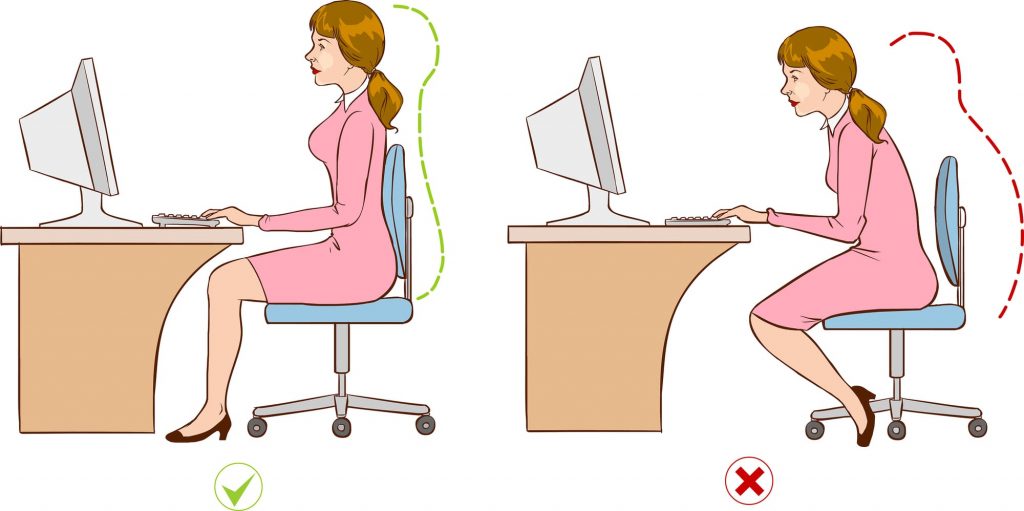
The upper frame of your computer screen should be around eye level so you can look down slightly while working, leaving your neck in a relaxed position.
Also, your monitor should be around one arm’s length away, depending on its size.
The right chair

Use a decent ergonomic chair with all the adjustments you need to work ergonomically.
Your armrests should be adjustable and short, so they don’t bump into the desk when getting closer.
It also should have lumbar support for your back and thick cushioning for a comfortable experience while sitting.
Mesh is a great material because it’s light and breathable, but that’s not a must.
Active Lifestyle
There can be reasons why you can’t use a standing desk. Maybe your boss doesn’t allow it at your workplace, maybe your focus decreases while standing due to your kind of computer work.
Either way, an active lifestyle will help to conquer the effects of a static work posture throughout the day.
It will help you decrease your blood sugar levels, weight loss by burning calories, and benefit your health overall.
According to associate Professor Bethany Barone Gibbs Ph.D., standing desks will also help reduce back problems, as shown in a study at the University of Pittsburgh [10].
You don’t have to go to the gym necessarily, you can start off by adding a few extra steps in your activity of daily life.
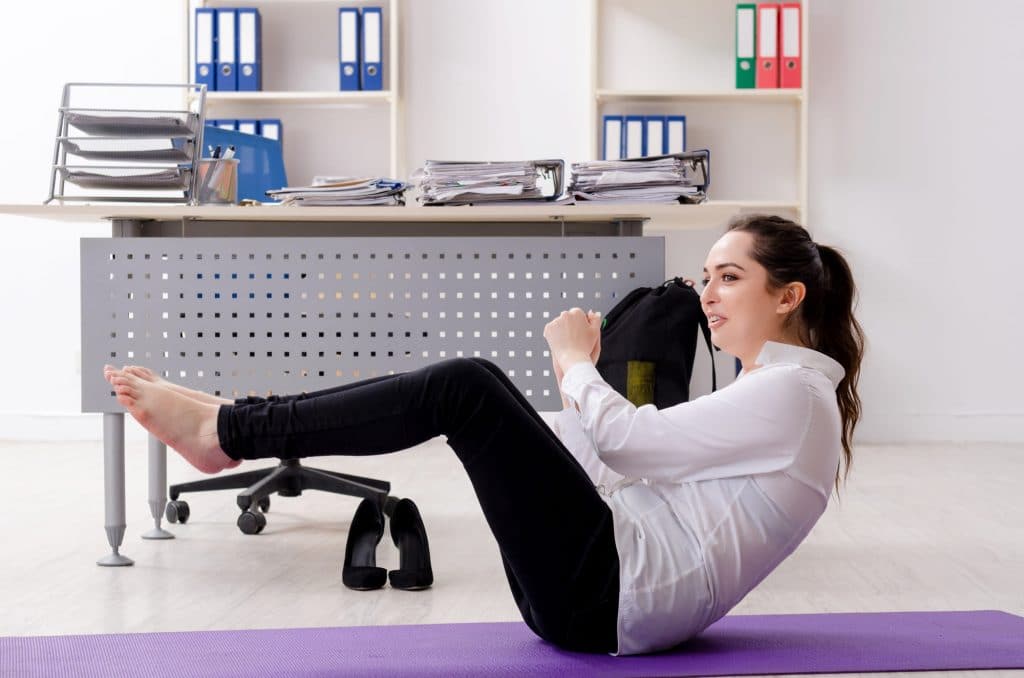
The British Medical Journal published a study [11] that shows you can increase your life expectancy by two years when you reduce your daily sedentary time to less than 3 hours and television viewing to less than 2 hours.
Just don’t be a couch potato!
Desk bikes and treadmills
Have you ever heard about a treadmill desk? There is an upcoming trend for treadmill and bike desks.
Many people already understand that activity is key for your health, even in your work environment.
Of course, it’s not suitable for every kind of desk work, but if you can get that little extra energy expenditure and burn more calories, why not?
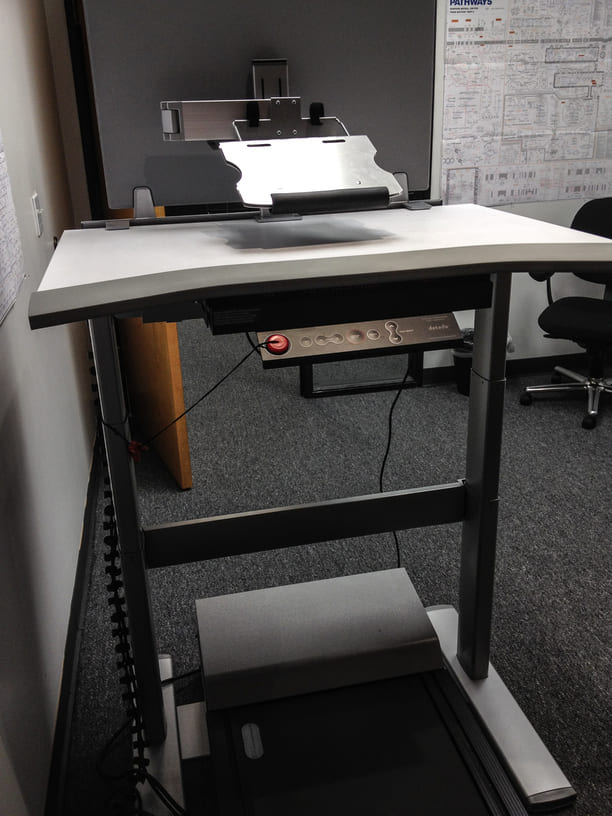
Frequently Asked Questions
Is it better to stand all day or sit all day?
It’s neither better to sit or to stand all day. The key to a healthier workplace is to constantly change in between those positions.
Is it bad to use a standing desk all day?
Yes, it’s bad to use a standing desk all day. They are not designed to be used in a constant static position but help you to switch up your positions throughout the day.
Conclusion: Standing vs Sitting
As you can see there is no direct answer to the question, if standing is better than sitting for your health.
It’s not standing vs sitting but sitting AND standing.
It’s about staying in a static position, it’s about getting some extra activity by constantly switching up your positions.
That is the idea behind a standing desk. It gives you the opportunity to decrease sedentary time, straighten your legs and release some pressure from your spine, abs, and hip flexors.
Remember: Health issues originate in inactivity.
Thus a standing desk is suitable for every person who can stand. Of course, not everyone will have the same starting point depending on your health conditions.
But everyone can start gradually with just a couple of minutes to start improving their physical capacity and well-being overall.

